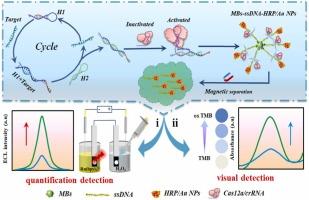基于 HRP/Au NPs 复合探针和 CRISPR/Cas12a 策略的 miRNA-21 的 ECL 和可视双模式检测
IF 8
1区 化学
Q1 CHEMISTRY, ANALYTICAL
引用次数: 0
摘要
信号放大传感策略可快速准确地检测肿瘤标志物 miRNA,对癌症的预防和治疗具有重要的现实意义。催化发夹组装(CHA)核酸扩增反应和CRISPR/Cas12a策略因其灵活的设计和高效的信号放大而展现出巨大的前景。我们构建了一种基于辣根过氧化物酶/金纳米粒子(HRP/Au NPs)纳米复合探针和CRISPR/Cas12a(LbCpf1)的电化学发光(ECL)生物传感器,完成了对miRNA-21的双模式检测。当系统中存在目标RNA时,启动CHA)循环,生成含有特定protospacer adjacent motif(PAM)碱基序列的双链DNA,成功激活CRISPR/Cas12a的转切活性。制备的 HRP/Au NPs 纳米复合探针被 CRISPR/Cas12a 切割后,含有 HRP 的上清液通过磁性分离被收集,随后被引入双极电极的阴极,促进阳极 ECL 发光反应。此外,还将上清液加入 TMB 致色液中进行致色反应。这样,就实现了对 miRNA-21 的 ECL 检测和肉眼检测。双模式检测提高了传感器的准确性,而在铟锡氧化物(ITO)镀膜玻璃上使用双极电极也为进一步开发用于早期癌症预防和诊断的护理点检测设备提供了有益的参考。本文章由计算机程序翻译,如有差异,请以英文原文为准。

ECL and visual dual-mode detection of miRNA-21 based on HRP/Au NPs composite probe and CRISPR/Cas12a strategy
Signal-amplification sensing strategies for rapid and accurate detection of tumor marker miRNA is of great practical significance for cancer prevention and treatment. Catalytic hairpin assembly (CHA) nucleic acid amplification reaction and CRISPR/Cas12a strategies have exhibited huge prospect due to their flexible design and efficient signal amplification. We constructed an electrochemiluminescence (ECL) biosensor based on horseradish peroxidase/gold nanoparticles (HRP/Au NPs) nanocomposite probe and CRISPR/Cas12a (LbCpf1), and completed a dual-mode detection of miRNA-21. When the target RNA is present in the system, the CHA) cycle was initiated, and the double-stranded DNA containing a specific protospacer adjacent motif (PAM) base sequence was generated to successfully activate the trans-cut activity of CRISPR/Cas12a. After the prepared HRP/Au NPs nanocomposite probe was cleaved by CRISPR/Cas12a, the supernatant containing HRP was collected through magnetic separation and subsequently introduced to the cathode of the bipolar electrode facilitating anodic ECL luminescence response. In addition, the supernatant was added to the TMB chromogenic solution for chromogenic reaction. Thus, ECL detection and visual detection of miRNA-21 were realized. Dual-mode detection improves the accuracy of the sensor, and the utilization of bipolar electrodes on indium tin oxide (ITO) coated glass could also provide some useful references for further development of point-of-care detecting devices for early cancer prevention and diagnosis.
求助全文
通过发布文献求助,成功后即可免费获取论文全文。
去求助
来源期刊

Sensors and Actuators B: Chemical
工程技术-电化学
CiteScore
14.60
自引率
11.90%
发文量
1776
审稿时长
3.2 months
期刊介绍:
Sensors & Actuators, B: Chemical is an international journal focused on the research and development of chemical transducers. It covers chemical sensors and biosensors, chemical actuators, and analytical microsystems. The journal is interdisciplinary, aiming to publish original works showcasing substantial advancements beyond the current state of the art in these fields, with practical applicability to solving meaningful analytical problems. Review articles are accepted by invitation from an Editor of the journal.
 求助内容:
求助内容: 应助结果提醒方式:
应助结果提醒方式:


